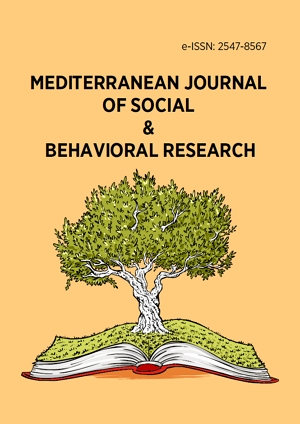Review Article
Empowering youth leaders in B40 marginalized communities: An innovative approach to social entrepreneurship in alignment with national entrepreneurship policy 2030
More Detail
1 Universiti Utara Malaysia, Sintok, Kedah, MALAYSIA* Corresponding Author
Mediterranean Journal of Social & Behavioral Research, 8(1), February 2024, 29-36, https://doi.org/10.30935/mjosbr/14306
Submitted: 20 October 2023, Published: 28 February 2024
OPEN ACCESS 759 Views 910 Downloads
ABSTRACT
A robust and sustainable entrepreneurial ecosystem that promotes economic growth and job creation is what Malaysia’s national entrepreneurship policy 2030 seeks to achieve. But in Malaysia, the B40 income group has a difficult time getting access to resources and possibilities for economic mobility (The World Bank, 2020). These disadvantaged groups frequently do not have access to the education, training, finance, and mentoring necessary to gain the knowledge and abilities necessary to succeed as entrepreneurs (Cheng & Mahmood, 2017). A paradigm that combines social responsibility, entrepreneurship, leadership, and education is needed to address this problem and build social entrepreneurs among marginalized youth leaders. This strategy should equip young people in B40 areas with the abilities, information, and resources necessary to establish long-lasting nonprofit organizations that meet the needs of their neighborhood while also generating cash. This concept could aid in developing a more inclusive and equitable entrepreneurial ecosystem in Malaysia, where everyone has the chance to thrive regardless of their background or socioeconomic level by encouraging a culture of innovation and entrepreneurship among marginalized youth leaders.
CITATION (APA)
Ab Rahman, F., & Raman, A. (2024). Empowering youth leaders in B40 marginalized communities: An innovative approach to social entrepreneurship in alignment with national entrepreneurship policy 2030. Mediterranean Journal of Social & Behavioral Research, 8(1), 29-36. https://doi.org/10.30935/mjosbr/14306
REFERENCES
- Abdullah, N., Tang, T. L., & Othman, N. (2019). Social entrepreneurship as a sustainable solution to alleviate poverty: A review on literature. Entrepreneurship and Sustainability Issues, 7(4), 2207-2225.
- About DKN 2030. (2015, December 21). https://www.smecorp.gov. my/index.php/en/policies/2015-12-21-09-09-50/about-dkn2030
- Ahmad, N. H., & Ismail, K. N. I. K. (2019). Social entrepreneurship in Malaysia: The role of culture and religion. Journal of Global Entrepreneurship Research, 9(1), 1-15.
- Aziz, N. A., & Abdullah, N. A. (2018). The influence of culture on social entrepreneurship intention among Malay youth in Malaysia. Journal of Entrepreneurship Education, 21(2), 1-10.
- Bacq, S., & Janssen, F. (2011). The multiple faces of social entrepreneurship: A review of definitional issues based on geographical and thematic criteria. Entrepreneurship & Regional Development, 23(5-6), 373-403. https://doi.org/10.1080/08985626.2011.577242
- Biji-Biji Initiative. (n. d.). About us. https://www.bijibiji.co/about-us/
- Budinich, V., & Davenport, J. (2019). The role of social entrepreneurship in sustainable development. Journal of Cleaner Production, 232, 1268-1280.
- Cheng, K. M., & Mahmood, R. (2017). Entrepreneurship education: A review of its objectives, teaching methods, and impact indicators. Journal of Entrepreneurship Education, 20(1), 1-16.
- Dees, J. G. (1998). The meaning of “social entrepreneurship.” The Kauffman Center for Entrepreneurial Leadership.
- DuBois, D. L., Portillo, N., Rhodes, J. E., Silverthorn, N., & Valentine, J. C. (2011). How effective are mentoring programs for youth? A systematic assessment of the evidence. Psychological Science in the Public Interest, 12(2), 57-91. https://doi.org/10.1177/1529100611414806
- Elkington, J. (1997). Cannibals with forks: The triple bottom line of 21st-century business. New Society Publishers. https://doi.org/10.1002/tqem.3310080106
- Goyal, N. (2018). Social entrepreneurship as a strategy for social change. Global Business Review, 19(4), 931-943.
- Ismail, K. N. I. K., & Ahmad, N. H. (2019). Social entrepreneurship education in Malaysia: A review of current practices and future directions. Journal of Global Entrepreneurship Research, 9(1), 1-15.
- Ismail, K. N. I. K., Ahmad, N. H., & Ismail, N. A. (2019). The effectiveness of social entrepreneurship education: A review of literature and future research agenda. Journal of Entrepreneurship Education, 22(S2), 1-13.
- Kamaruddin, R., & Ismail, K. N. I. K. (2020). The role of social entrepreneurship education in developing entrepreneurial intention among Malaysian youths. Journal of Entrepreneurship Education, 23(2), 1-11.
- Khairuddin, I., Yusoff, R. Z., & Ahmad, N. A. (2019). The development of entrepreneurship education in Malaysia. Journal of Entrepreneurship Education, 22(3), 1-10.
- MaGIC. (n. d.). Programs. Malaysian Global Innovation & Creativity Center. https://mymagic.my/programs/
- Mair, J., & Martí, I. (2006). Social entrepreneurship research: A source of explanation, prediction, and delight. Journal of World Business, 41(1), 36-44. https://doi.org/10.1016/j.jwb.2005.09.002
- Martin, R. L., & Osberg, S. (2007). Social entrepreneurship: The case for definition. Stanford Social Innovation Review, 5(2), 28-39.
- Mohd Ariffin, N. A., & Hassan, R. (2020). Women’s social entrepreneurship in Malaysia: The role of culture and social capital. Journal of Entrepreneurship in Emerging Economies, 12(3), 434-454.
- Sarstedt, M., Ringle, C. M., Smith, D., Reams, R., & Hair Jr, J. F. (2019). Partial least squares structural equation modeling (PLS-SEM): A useful tool for family business researchers. Journal of Family Business Strategy, 10(3), 1-12.
- SEAP. (n. d.). Social enterprise accreditation program. https://www.seap.asia/
- The World Bank. (2020). Malaysia economic monitor: Weathering the COVID-19 storm. The World Bank. https://www.worldbank.org/en/country/malaysia/publication/malaysia-economic-monitor-june-2020-weathering-the-covid-19-storm

 The articles published in this journal are licensed under the CC-BY Creative Commons Attribution International License.
The articles published in this journal are licensed under the CC-BY Creative Commons Attribution International License.